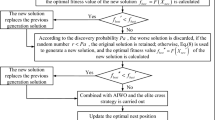Abstract
The fuzzy c-means (FCM) algorithm is the most popular clustering method. Many studies of FCM had been done. However, the FCM algorithm and its studies are usually affected by the selection of initial values and noise data, and can easily fall into local optimal value. To overcome these drawbacks of FCM, this paper proposed the algorithm of FCM based on multi-chain quantum bee colony algorithm (MQBC-FCM). In MQBC-FCM, first, the multiple chains encoding method is introduced to the artificial bee colony algorithm to propose the MQBC algorithm. Then MQBC is used to search for the optimal initial clustering centers. The proposed algorithm is used on artificial data sets and image segmentations, and its performance is contrasted with several algorithms. The experimental results have indicated that the proposed MQBC-FCM has efficiently improved the performance of the clustering algorithm.












Similar content being viewed by others
References
Karaboga, D., & Ozturk, C. (2011). A novel clustering approach: Artificial Bee Colony (ABC) algorithm. Applied Soft Computing, 11(1), 652–657.
Dunn, J. C. (1974). A fuzzy relative of the ISODATA process and its use in detecting compact well separated clusters. Journal of Cybernetics, 3(3), 32–57.
Bezdek, J. C. (1974). Numerical taxonomy with fuzzy sets. Journal of Mathematical Biology, 1(1), 57–71.
Bezdek, J. C. (1974). Cluster validity with fuzzy sets. Journal of Cybernetics, 3(3), 58–72.
Wang, X., Wang, Y., & Wang, L. (2004). Improving fuzzy c-means clustering based on feature-weight learning. Pattern Recognition Letters, 25(10), 1123–1132.
Pal, N. R., Pal, K., Keller, J. M., & Bezdek, J. C. (2005). A possibilistic fuzzy c-means clustering algorithm. IEEE Transactions on Fuzzy Systems, 13(4), 517–530.
Song, Y.-S., Park, D.-C., Tran, C. N., Choi, H.-S., & Suk, M. (2006). Fuzzy c-means algorithm with divergence-based kernel. International Conference on Fuzzy Systems and Knowledge Discovery, 2006, 99–108.
Liu, X., & Li, X. (2007). Performance research of Gaussian function weighted fuzzy c-means algorithm. International Symposium on Multispectral Image Processing and Pattern Recognition, 6788, 1–7.
Yang, M.-S., & Tsai, H.-S. (2008). A Gaussian kernel-based fuzzy c-means algorithm with a spatial bias correction. Pattern Recognition Letters, 29(12), 1713–1725.
Kaur, P., & Gosain, A. (2011). A density oriented fuzzy c-means clustering algorithm for recognising original cluster shapes from noisy data. International Journal of Innovative Computing and Applications, 3(2), 77–87.
Havens, T. C., Bezdek, J. C., Leckie, C., Hall, L. O., & Palaniswami, M. (2012). Fuzzy c-means algorithms for very large data. IEEE Transactions on Fuzzy Systems, 20(6), 1130–1146.
Izakian, H., Pedrycz, W., & Jamal, I. (2013). Clustering spatiotemporal data: An augmented fuzzy C-means. IEEE Transactions on Fuzzy Systems, 21(5), 855–868.
Rodriguez, A., & Laio, A. (2014). Clustering by fast search and find of density peaks. Science, 344(6191), 1492–1496.
Fazendeiro, P., & de Oliveira, J. V. (2015). Observer-biased fuzzy clustering. IEEE Transactions on Fuzzy Systems, 23(1), 85–97.
Pimentel, B. A., & de Souza, R. M. C. R. (2013). A multivariate fuzzy c-means method. Applied Soft Computing, 13(4), 1592–1607.
Lin, K.-P. (2014). A novel evolutionary kernel intuitionistic fuzzy c-means clustering algorithm. IEEE Transactions on Fuzzy Systems, 22(5), 1074–1087.
Yang, M.-S., & Nataliani, Y. (2017). Robust-learning fuzzy c-means clustering algorithm with unknown number of clusters. Pattern Recognition, 71, 45–59.
Ding, Y., & Fu, X. (2016). Kernel-based fuzzy c-means clustering algorithm based on genetic algorithm. Neurocomputing, 188, 233–238. https://doi.org/10.1016/j.neucom.2015.01.106.
Duan, L., Yu, F., & Zhan, L. (2016). An improved fuzzy c-means clustering algorithm. In 2016 12th international conference on natural computation, fuzzy systems and knowledge discovery (Vol. 12, pp. 1199–1204).
Chang, X., Wang, Q., Liu, Y., & Wang, Y. (2017). Sparse regularization in fuzzy c-means for high-dimensional data clustering. IEEE Transactions on Cybernetics, 47(9), 2616–2627.
Tang, S., Peng, G., & Zhong, Z. (2016). An improved fuzzy c-means clustering algorithm for transformer fault. In 2016 China international conference on electricity distribution, 2016 (pp. 1–5).
Pimentel, B. A., & de Souza, R. M. C. R. (2016). Multivariate fuzzy c-means algorithms with weighting. Neurocomputing, 174, 946–965.
Jing, Gu, Jiao, Licheng, Yang, Shuyuan, & Zhao, Jiaqi. (2017). Sparse learning based fuzzy c-means clustering. Knowledge-Based Systems, 119, 113–125.
Liu, X., Zhang, L., & Li, Z. (2010). Clustering optimization based on ant colony algorithm. Computer Engineering, 36(9), 190–191.
Zhao, X., & Zhang, S. (2011). The artificial colony KFCM algorithm based on the Boltzmann selection. Journal of Lanzhou University of Technology, 37(1), 71–75.
He, J., Wang, J., & Zhiyong, Y. (2016). Clustering algorithm based on modified artificial bee colony and fuzzy c-means algorithm. Computer Application Research, 33(5), 1342–1345.
Li, S., & Li, P. (2006). Quantum genetic algorithm based on real encoding and gradient information of object function. Journal of Harbin Institute of Technology, 38(8), 1216–1223.
Li, P., & Li, S. (2008). Quantum-inspired evolutionary algorithm for continuous space optimization based on Bloch coordinates of qubits. Neurocomputing, 72(1–3), 581–585.
Wang, Z., Zhang, H., Zhang, R., Xing, Y., & He, J. (2012). Quantum genetic algorithm based on multi-chain coding scheme. Application Research Computers, 29(26), 2061–2064.
Krishnasamy, G., Kulkarni, A. J., & Paramesran, R. (2014). A hybrid approach for data clustering based on modified cohort intelligence and K-means. Expert Systems with Applications, 41(13), 6009–6016.
Bezdek, J. C. (1973). Cluster validity with fuzzy sets. Cybernetics and System, 3(3), 58–73.
Bezdek, J. C. (1975). Mathematical models for systematic and taxonomy. In Proceedings of 8th international conference on numerical taxonomy, 1975 (pp. 143–166).
Acknowledgements
Funding was provided by National Natural Science Foundation of China (Grant No. 71501186).
Author information
Authors and Affiliations
Corresponding author
Rights and permissions
About this article
Cite this article
Feng, Y., Lu, H., Xie, W. et al. An Improved Fuzzy C-Means Clustering Algorithm Based on Multi-chain Quantum Bee Colony Optimization. Wireless Pers Commun 102, 1421–1441 (2018). https://doi.org/10.1007/s11277-017-5203-2
Published:
Issue Date:
DOI: https://doi.org/10.1007/s11277-017-5203-2




